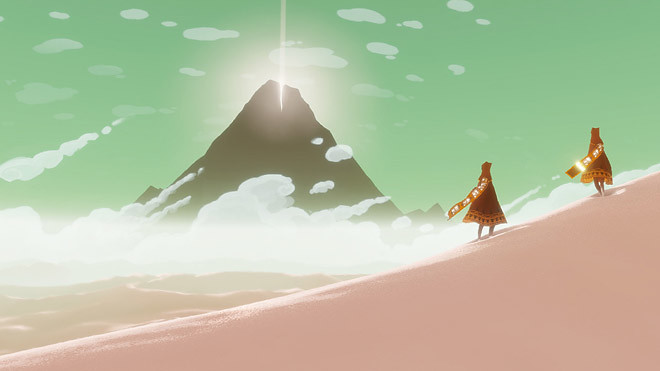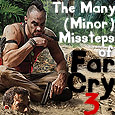
From playing its beta, the biggest question Journey seemed to be asking me was, "how do you react to solitude?"
Skimming through the desolate, shimmering ocean of sand in Journey might feel familiar if you played Shadow of the Colossus, a game that cast the player as a young man named Wander as he explored an ancient, ruined land on a violent quest for love. The player often had to travel for long stretches in near-silence and isolation, nothing to keep him company other than his horse, Agro. And in this isolation, many players found a poignant and deeply affecting meaning to the increasing amount of blood on their hands.
While there's no indication that you'll be scaling 50-foot Colossi or engaging in anything remotely close to "combat" once Journey hits for real later this year, the game still struck the same chord in me that Shadow of the Colossus did in 2005.

Journey begins pretty low-key, with you controlling a mysterious, robed character standing in the desert. It teaches you very quickly that you can turn the camera with the SIXAXIS motion controls or the right analog stick and move with the left analog stick. It's not as immediately remarkable as developer thatgamecompany's last two games — flOw and Flower, both controlled entirely via SIXAXIS and one button — but it's much more accessible in return.
In its beta, the game relies entirely on camera cues to direct you where to go, reserving more blunt text directions for introducing control mechanics that couldn't really be explained otherwise. It's a smart system, but if you're opting for the graceful sweeps of SIXAXIS camera control, it can be a little jarring to have that control temporarily wrenched from you without warning.
So you'll trek from one dune to another, endlessly admiring the glistening sand that acts more like shallow water, until you come across the various ruins of some ancient civilization. It's your choice whether to go out of your way to explore, or just follow the critical path.
You'll get the ability to jump pretty early on, but it doesn't function like in most games. Here, you have to earn each jump by finding floating scraps of cloth. And if you search out collectable white orbs, your character's scarf will grow longer and you'll be able to jump higher. It's an odd system, and I'm not sure how much it adds yet.
But that's the point. At its core, Journey is a game that's all about limitations: limitations in your control, limitations in your character's abilities, limitations in your interactions with the world around you. Like Shadow of the Colossus, you're almost always deprived of any surrounding life. Unlike Shadow, though, where the player formed an active bond with Agro and an inactive one with Mono, Wander's unconscious lady love, in Journey, you're totally alone.
And that's where it gets interesting. In theory, anyway.

Journey's big promise is in how it starves you for human connection. It'll pair you up with another player — you won't know who — and you'll be able to travel with him, or ignore him completely until he's removed from your game automatically. You can only communicate with that player via a "sing" ability where your character makes a noise and briefly emanates a white, ethereal glow.
Unfortunately, in the beta, thatgamecompany was only turning on the multiplayer at certain times, so I was never able to push through the hot sands with a companion. Instead, I was left with questions of how the system will work. For instance, can you boot the other player out if you don't like him? Will he be able to trigger cutscenes before I'm ready to move on? Will we be able to reach areas one player can't? And most importantly, how will another human player, an agent of chaos in an otherwise controlled, scripted world, change the emotional experience?
Journey's big promise is in how it starves you for human connection.
What I'm sure of, though, is how jarring it is to see anything resembling a living creature in Journey. In one part of the beta, I came across a kind of red kite that came to life when I approached it. It picked me up for a moment, almost playfully, before swooping away and diving into the sand. It emerged a little farther away, swimming through the sand as naturally and elegantly as a dolphin through water. It seemed to be beckoning me to follow. So I did.
It ushered me over dune after dune, and I slid down each one, racing along to catch up. Finally, we arrived at another set of ruins, where I gave life to four smaller kites. One picked me up as the rest circled, then we all took off on our next adventure. I wasn't alone anymore, and it felt invigorating. They led me to a white upgrade orb, then we kept moving, the music picking up and getting a lively bounce. But the ground rumbled for a moment, and my new friends rushed ahead.
I panicked, watching them dart over the horizon and out of sight. As I finally reached the top of the dune, I saw little red specks fly upward into a darkening sky, and I knew I was alone again.
This is the part of Journey that intrigues me the most. That it so quickly got me to feel a connection to these odd little kites is extremely promising for the rest of the game. Exploring the cracked, dry ruins of an old civilization and making my way to the glowing mountain looming in the distance were definitely intriguing aspects in this short beta, but my relationship with the pieces of the world still retaining a spark of life was far more compelling.
Journey is scheduled to release later this year for the PlayStation 3.
 Tweet
Tweet 




















No comments:
Post a Comment